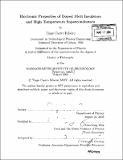| dc.contributor.advisor | Xiao-Gang Wen. | en_US |
| dc.contributor.author | Ribeiro, Tiago Castro | en_US |
| dc.contributor.other | Massachusetts Institute of Technology. Dept. of Physics. | en_US |
| dc.date.accessioned | 2006-11-07T11:53:26Z | |
| dc.date.available | 2006-11-07T11:53:26Z | |
| dc.date.copyright | 2005 | en_US |
| dc.date.issued | 2005 | en_US |
| dc.identifier.uri | http://hdl.handle.net/1721.1/34383 | |
| dc.description | Thesis (Ph. D.)--Massachusetts Institute of Technology, Dept. of Physics, 2005. | en_US |
| dc.description | Includes bibliographical references (p. 129-140). | en_US |
| dc.description.abstract | High-temperature superconducting cuprates, which are the quintessential example of a strongly correlated system and the most extensively studied materials after semiconductors, spurred the development in the fields of material science and experimental and theoretical physics. As first noted by Anderson, these materials are doped Mott insulators and the novel phenomenology emerges in the regime intermediate to the Neel state and the Fermi liquid metal where electrons evolve from being local moments to itinerant entities. This thesis attempts to describe the evolution of the electronic properties between the above two limits as of interest to high-temperature superconductors. We use the tt't"J model to describe doped Mott insulators and resort to numerical methods and to both well known and new approximate analytical techniques to deal with the absence of on-site double electron occupancy. We first address the problem of a single hole in the tt't"J model in terms of the exact diagonalization and the self-consistent Born approximation methods. We show spins dress the doped hole in two distinct ways, namely with a staggered moment and a liquid spin configurations. The resulting two-band picture captures the momentum space anisotropy consistent with experimental observations in underdoped cuprates. Next we use the SU(2) slave boson mean-field theory of the tt'J model. The role of next-nearest-neighbor hopping t' on the phase diagram is studied. We find that when t' > 0.5J a Z2 state with true spin-charge separation exists, which can be a candidate for an eventual pseudogap phase in electron doped materials. | en_US |
| dc.description.abstract | (cont.) We then derive a new formulation of the tt't"J model in terms of holes instead of electrons and introduce a mean-field description of doped Mott insulators that provides an effective two-fluid model of vacancies which captures the effect of staggered moment and d-wave singlet bond short-range spin correlations on the hole dynamics. It leads to a mean field phase diagram consistent with that of hole and electron doped cuprates. Moreover, it provides a framework to describe the observed evolution of the electron spectral function from the undoped insulator to the overdoped Fermi metal, as we conclude from extensively comparing the mean-field results to non-trivial angle-resolved photoemission spectroscopy and tunneling conductance data. | en_US |
| dc.description.statementofresponsibility | y Tiago Castro Ribeiro. | en_US |
| dc.format.extent | 140 p. | en_US |
| dc.format.extent | 10454345 bytes | |
| dc.format.extent | 11047242 bytes | |
| dc.format.mimetype | application/pdf | |
| dc.format.mimetype | application/pdf | |
| dc.language.iso | eng | en_US |
| dc.publisher | Massachusetts Institute of Technology | en_US |
| dc.rights | M.I.T. theses are protected by copyright. They may be viewed from this source for any purpose, but reproduction or distribution in any format is prohibited without written permission. See provided URL for inquiries about permission. | en_US |
| dc.rights.uri | http://dspace.mit.edu/handle/1721.1/7582 | |
| dc.subject | Physics. | en_US |
| dc.title | Electronic properties of doped Mott insulators and high temperature superconductors | en_US |
| dc.type | Thesis | en_US |
| dc.description.degree | Ph.D. | en_US |
| dc.contributor.department | Massachusetts Institute of Technology. Department of Physics | |
| dc.identifier.oclc | 70136606 | en_US |
